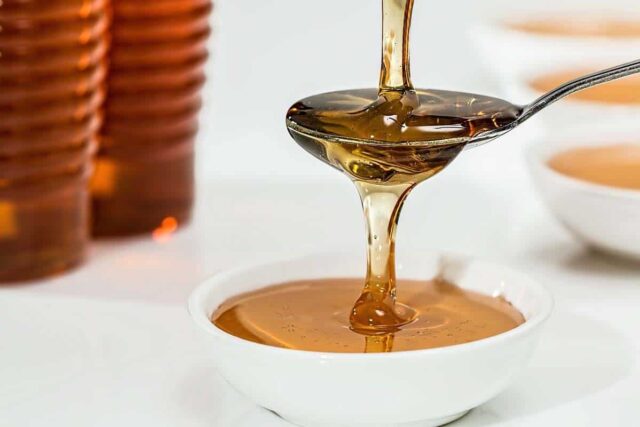Honey is a natural food manufactured by bees. It offers enormous nutritional and health benefits. Most people also prefer it to white table sugar.
Bees work hard to produce honey. Therefore, the least we can do for these creatures is helping to decide honey’s food group.
So, what food group is honey in?
Honey belongs to the group called “sugar and sweeteners.” That’s the general view. Regulators in various countries have also given their stand on where honey belongs.
According to the FDA, honey is a nutritive sweetener. It can also be called a caloric sugar or sweetener, which gives the body energy as carbs. The USDA also categorizes honey as an “added sugar” in its Food Guide Pyramid.
To the Canadian regulators, honey is a “sugar-based ingredient.” The reason is that it functions as a sweetening agent.
Honey may have higher nutritional value and health benefits than other sweeteners. But it also boasts higher calories.
Honey should also be consumed in moderation because it influences blood sugar. It can cause blood sugar levels to increase.
Let’s talk more about honey. Continue reading!
What Group Should Honeys Be In?
Honey is natural and sweet. It’s often used as a substitute for other sweeteners because of its nutritional value, health benefits, and sweetness.
Honey originates from flower nectar, which is the basic reason many are confused about what group it should be in.
Bees gather nectars and break them down into simple sugar, using some compounds in their saliva. After that, the product is then kept in the honeycomb.
Keep in mind that the honey production process is far more complex than the explanation above. But regardless of the nectar’s origin, whether from the Manuka tree or wildflower, honey is processed by bees the same way.
You will only discover some slight differences in color and flavor. For example, honey from wildflower nectar tends to have a slightly different flavor and darker color than honey from orange blossom nectar.
Honey is broken down into simple sugar. So, it’s wise to classify them as “sugars and sweeteners.”
As a sugar, honey falls into the group of foods called carbohydrates. Carbs are the highest among the varied nutritional components in these foods. For the records, a100g honey boasts 76.4g of carbs.
Note – Because of its high carbs and functional properties, honey is revered by athletes. Honey a great source of energy. It can help athletes achieve their performance goals.
How Honey Compares To Sugar
Honey is sweet, and so is sugar. But there are notable differences between both sweeteners.
Research shows that honey boasts minute amounts of minerals, proteins, vitamins, and antioxidants, making it a bit healthier than table sugar.
Furthermore, honey is a combination of fructose and glucose, which are the same sugary substances present in the table (granulated) sugar.
In table sugar, while fructose is 50%, glucose is 50%. Fructose and glucose in honey are 40 and 30 percent, respectively.
Honey also contains calories. It contains higher calories than granulated sugar. It also boasts higher carbs than granulated sugar.
Another thing that differentiates honey from granulated sugar is that the former is much sweeter. It literarily contains more sugars than the latter.
On the Glycemic Index (GI) chart, sugar is higher than honey. So, even though honey causes blood sugar spike, granulated sugar is far worse. It causes a spike in blood sugar levels much quicker.
Again, honey’s high fructose levels and low glycemic index makes it a great sugar substitute.
One study reported that substituting sugar for honey could help to aid weight loss, prevent weight gain, and reduce blood sugar levels.
Furthermore, because honey is sweeter than granulated sugar, you only need to apply a small quantity to your food item.
Price is another factor that separates both sweeteners. It’s a well-known fact that raw honey cost more than granulated sugar of the same quantity.
Raw honey also contains more nutrients, and it’s less processed than table sugar.
On the digestive system, honey is quite easier to digest than table sugar. The reason is that one has to ingest the table sugar first before it gets broken down.
However, enzymes are part of honey’s constituents, thanks to its manufacturers, bees. So, literarily, honey is partially broken down even before you consume it. And this makes it super easy to digest, compared to table sugar.
Benefits Of Consuming Honey
In ancient time, honey was more than a sweetening agent. It was widely used in medicine.
Below are honey’s components to let you understand how beneficial it can be health-wise.
- Antioxidants
- Minerals
- Vitamins
- Enzymes
- Amino acids
Note – Honey comes in varied colors, which also influences some of its components’ levels. For instance, research suggests that dark honey may boast higher antioxidants levels than light-colored ones.
In the same vein, raw honey may contain higher enzymes and antioxidants than the pasteurized one.
Here are the awesome health benefits of honey.
Honey as a topical medication:
Traditionally, honey’s use as topical medication has been well-documented. It’s not only used in promoting healing. Honey aids the prevention of infection in skin burns, wounds, surgical wounds, diabetic foot ulcers, and ulcerations.
One study has proven how effective raw honey is in improving seborrheic dermatitis, a condition marked by flaky and itchy scalp.
Weekly application of raw honey on the affected area also helped prevent hair loss, as observed in this study’s participants.
Honey as a broad-spectrum antibiotic:
Bacteria can develop resistance to a range of drugs, but not when it involves honey. Honey’s therapeutic potential is well-documented. It’s called a broad-spectrum antibiotic because it can treat a range of infections. Your doctor’s order is also important. Please make sure you abide by it.
Honey’s antiviral properties:
Compared to other infectious diseases, viruses are quite difficult to treat. The reason is that they can remain infectious even in dry mucus for such a long period.
But the good news is honey, particularly the Manuka honey, has shown impressive antiviral properties. One study on Manuka honey’s antiviral properties proves that it effectively treats the varicella-zoster virus, which causes chickenpox in adults and children.
Conclusion
At this point, you should already know the answer to the question, “what food group is honey.” Honey is a sugar and sweetener. According to the USDA, honey is classified as an added sugar.
This post contains information about honey, including its health benefits. We hope you found it helpful.
You May Like These Articles As Well:








![What Is The Value Of X? [Art Not To Scale.] X = 23 X = 35 X = 58 X = 93 :Exploring Art And Math What Is The Value Of X [Art Not To Scale.] X = 23 X = 35 X = 58 X = 93 Exploring Art And Math](https://southslopenews.com/wp-content/uploads/2024/09/What-Is-The-Value-Of-X-Art-Not-To-Scale.-X-23-X-35-X-58-X-93-Exploring-Art-And-Math-300x194.jpg)





